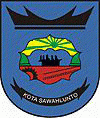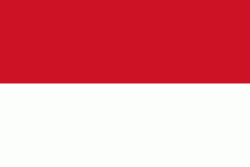Sawahlunto (Kota Sawah Lunto)
 |
Sawahlunto is one of the mining towns in West Sumatra. It was first established as a town in 1882 by the Dutch along with coal mining operations. Coal was discovered in the mid-19th century by Ir. de Greve. It was then suggested to the Dutch that coal should be mined in the area because coal was needed for industry and transportation. After the discovery of coal the area was frequently visited by geologists. Coal mining was pioneered in the area after the eventual "surrender" of the area to the Dutch in 1876. After the golden period of mining and the closure of the mine sites, Sawahlunto became a ghost town and the population declined. In 2004, the city's policy became to turn Sawahlunto into a tourist city, since when the population has increased. In 2014, 29 percent of its income came from tourism, while only 23 percent came from farming.
The Ombilin coal mining site at Sawahlunto has been listed as a UNESCO World Heritage Site in 2019.
Sawahlunto is one of the many towns located in the area of Bukit Barisan West Sumatra, but with a history different from the other towns. Towns such as Bukittinggi, Batusangkar, Payakumbuh, Padang Panjang and Solok were shaped by the Minang community, while Sawahlunto was created by the mining business during the colonisation of the Dutch in 1888. Coal was discovered in the mid-19th century by Ir. de Greve. It was then suggested to the Dutch that coal should be mined in the area because coal was needed for industry and transportation. After the discovery of coal the area was frequently visited by geologists. Coal mining was pioneered in the area after the eventual "surrender" of the area to the Dutch in 1876.
Coal mining had significantly changed the rural landscape of Sawahlunto into an industrial site. During its development in the 19th century, mining companies designed the Sawahlunto mining site into five spatial activities: coal mining industry, commercial and trade areas, residential areas, administrative areas, and health utilities. In order to support its activities, the Netherlands built several transportation networks such as creating a railway network to transport coal from Sawahlunto to the west coast of Sumatra. The Dutch East Indies also built Emmahaven Port (known as Teluk Bayur) and became a shipping port for coal exports, using steamers SS Sawahlunto and SS Ombilin-Nederland. Meanwhile, in 1887–1892, they began building a train from Pulau Air Padang to Muaro Kalaban and from this station to the Sawahlunto area.
* In 1888 the Nederland Indies initialised many coal mining facilities
* In 1894 train tracks were opened
* In 1898 the first coal mining tunnel was built at Air Dingin, Lembah Segar, but was later closed in 1932 and re-opened again in June 2007. Sawahlunto started becoming a residential area for coal miners when the Dutch Indies government invested 5.5 million [gulden] (the Dutch currency at that time) to build various facilities to manage the coal mining industry Ombilin. This residential area continued to expand to become a small town which consisted mainly of officers and coal miners.
The Dutch also built a train system costing 17 million gulden as a mode for coal to be transported out from Sawahlunto through Padang. Trains have been in operation since 1888 but only recently reached Muara kalaban and later on reaching Sawahlunto in 1894. Having trains as a mode of transport brought in huge profits from the investment from only tens of thousands to hundreds of thousands tons of coal per year. Losses turned into big profits as much as 4.6 million gulden in a year in 1920. Until 1898, the coal mining business still used forced labour, known as narapaidana, who were forced to work with minimum wage. In 1908 wages for forced labour was 18 cents/day and they were subjected to whips under legal sanctions should they rebel. Wages for contract workers were 32 cents/day and they were entitled to housing facilities and healthcare facilities. Meanwhile, wages for other labourers were 62 cents/day without benefits (Zubir,1995). With that, you can picture Sawahlunto to be a prisoner camp for the forced workers in the early 20th century.
In 1918 Sawahlunto was known as Gemeentelijk Ressort or Gemeente with a land area of 778 ha. The name was given to mark its success in coal mining activities at that time. The total population in 1930 was 43,576 consisting of 564 Europeans. Even though Sawahlunto had yet to become Stadsgemeente, the management of the town was done by Stadsgemeenteraad (DPRD) and Burgemeester (Walikota).
Map - Sawahlunto (Kota Sawah Lunto)
Map
Country - Indonesia
 |
 |
| Flag of Indonesia | |
As the world's third largest democracy, Indonesia is a presidential republic with an elected legislature. It has 38 provinces, of which nine have special status. The country's capital, Jakarta, is the world's second-most populous urban area. Indonesia shares land borders with Papua New Guinea, East Timor, and the eastern part of Malaysia, as well as maritime borders with Singapore, Vietnam, Thailand, the Philippines, Australia, Palau, and India. Despite its large population and densely populated regions, Indonesia has vast areas of wilderness that support one of the world's highest level of biodiversity.
Currency / Language
| ISO | Currency | Symbol | Significant figures |
|---|---|---|---|
| IDR | Indonesian rupiah | Rp | 2 |
| ISO | Language |
|---|---|
| NL | Dutch language |
| EN | English language |
| ID | Indonesian language |
| JV | Javanese language |















